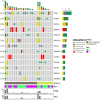Genomic events stratifying prognosis of early gastric cancer
- PMID: 39028418
- PMCID: PMC11513700
- DOI: 10.1007/s10120-024-01536-z
Genomic events stratifying prognosis of early gastric cancer
Abstract
Background: The purpose of the study was to conduct a comprehensive genomic characterization of gene alterations, microsatellite instability (MSI), and tumor mutational burden (TMB) in submucosal-penetrating (Pen) early gastric cancers (EGCs) with varying prognoses.
Methods: Samples from EGC patients undergoing surgery and with 10-year follow-up data available were collected. Tissue genomic alterations were characterized using Trusight Oncology panel (TSO500). Pathway instability (PI) scores for a selection of 218 GC-related pathways were calculated both for the present case series and EGCs from the TCGA cohort.
Results: Higher age and tumor location in the upper-middle tract are significantly associated with an increased hazard of relapse or death from any cause (p = 0.006 and p = 0.032). Even if not reaching a statistical significance, Pen A tumors more frequently present higher TMB values, higher frequency of MSI-subtypes and an overall increase in PI scores, along with an enrichment in immune pathways. ARID1A gene was observed to be significantly more frequently mutated in Pen A tumors (p = 0.006), as well as in patients with high TMB (p = 0.027). Tumors harboring LRP1B alterations seem to have a higher hazard of relapse or death from any cause (p = 0.089), being mutated mainly in relapsed patients (p = 0.093).
Conclusions: We found that the most aggressive subtype Pen A is characterized by a higher frequency of ARID1A mutations and a higher genetic instability, while LRP1B alterations seem to be related to a lower disease-free survival. Further investigations are needed to provide a rationale for the use of these markers to stratify prognosis in EGC patients.
Keywords: ARID1A; LRP1B; EGC; Pen; Prognosis.
© 2024. The Author(s).
Conflict of interest statement
The authors declare that they have no conflict of interest.
Figures





References
-
- Sung H, Ferlay J, Siegel RL, et al. Global Cancer Statistics 2020: GLOBOCAN Estimates of Incidence and Mortality Worldwide for 36 Cancers in 185 Countries. CA Cancer J Clin. 2021;71:209–49. - PubMed
-
- Japanese Gastric Cancer A. Japanese Classification of Gastric Carcinoma - 2nd English Edition. Gastric Cancer 1998;1(1):10–24. - PubMed
-
- Morgagni P, Solaini L, Saragoni L, et al. An aggressive early gastric cancer: Kodama’s pena type. Eur J Surg Oncol. 2018;44:1186–90. - PubMed
-
- Suzuki H, Oda I, Abe S, et al. High rate of 5-year survival among patients with early gastric cancer undergoing curative endoscopic submucosal dissection. Gastric Cancer. 2016;19:198–205. - PubMed
MeSH terms
Substances
Grants and funding
LinkOut - more resources
Full Text Sources
Medical
Research Materials
Miscellaneous

